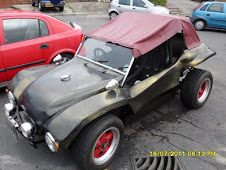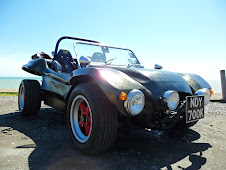 In the next couple of weeks I assessed the work and decided in which order my time should be spent. Ten years prior to this I had had the opportunity to work with fibreglass repairing canoes as a project with the school. Although this was useful, it was no way going to prepare me for the amount of fibre glassing that was ahead.
In the next couple of weeks I assessed the work and decided in which order my time should be spent. Ten years prior to this I had had the opportunity to work with fibreglass repairing canoes as a project with the school. Although this was useful, it was no way going to prepare me for the amount of fibre glassing that was ahead.You can see from the picture opposite the holes in the rear seat area where fairly large and looked structural.
The bodywork did not fit on the chassis as the sides of the fibreglass had seemed to have warped.
 These holes would have to be re fibre glassed and special attention would need to ensure that the new fibreglass did not encroach or hit the chassis. There where two additional holes at the corner of the tub across from the rear transom, these would need fibre glassing and would be quite difficult as they were on a corner. I decided to start with the easiest piece. I went to a local car accessory company and bought £50 of glass, resin and hardener. My Angle grinder game out of my toolbox with a 180 grit sanding disk on it made light work of the paint and talking me down to the fibreglass surface easily. Additionally I located a 5L can of Cellulose in the back of the garage. A friend suggested this as a cleaning agent and with experimentation I found that the cellulose would make the fibreglass sticky thus enhancing the new fibreglass's ability to get a good contact.
These holes would have to be re fibre glassed and special attention would need to ensure that the new fibreglass did not encroach or hit the chassis. There where two additional holes at the corner of the tub across from the rear transom, these would need fibre glassing and would be quite difficult as they were on a corner. I decided to start with the easiest piece. I went to a local car accessory company and bought £50 of glass, resin and hardener. My Angle grinder game out of my toolbox with a 180 grit sanding disk on it made light work of the paint and talking me down to the fibreglass surface easily. Additionally I located a 5L can of Cellulose in the back of the garage. A friend suggested this as a cleaning agent and with experimentation I found that the cellulose would make the fibreglass sticky thus enhancing the new fibreglass's ability to get a good contact.  The fibre glassing was going well access to the web was providing additional information about cutting in the new glass to the old by cutting a slope on the join. Before long I had built a box section up and filled the hole in the other side. The box section was built up slowly in layers . The trick seemed to be in getting the first layer of fibreglass in place and semi -hard. The best way of achieving this seemed to be by using a former made from steel sheeting and using household Libron wax polish to act as a greasing agent. Luckily I choose a wax polish that was removable by the cellulose, this meant it was easy to clean down before the next layer was attached. I was almost ready for a first fit but I needed to know whether the
The fibre glassing was going well access to the web was providing additional information about cutting in the new glass to the old by cutting a slope on the join. Before long I had built a box section up and filled the hole in the other side. The box section was built up slowly in layers . The trick seemed to be in getting the first layer of fibreglass in place and semi -hard. The best way of achieving this seemed to be by using a former made from steel sheeting and using household Libron wax polish to act as a greasing agent. Luckily I choose a wax polish that was removable by the cellulose, this meant it was easy to clean down before the next layer was attached. I was almost ready for a first fit but I needed to know whether the  new fibreglass work would hit any of the chassis members. It was time to ask my friend Ben to give me a hand to lift the body work back onto the chassis. I had made the battery area larger than it was originally as I wanted to place a bigger battery on board. Unfortunately I had not checked the larger area would fit in the hole in the between the chassis parts. It seemed as if the battery compartment had been designed small for a specific purpose. I had to cut the box section down so that it would fit between the chassis members. With the shape established and completed . My attention turned to the problem of the chassis not fitting the tub. There was about 2" of air between the chassis and the tub, this was marked out on the rear transom with wooden blocks so that the height could be gauged and a fit to the chassis could be made with the wooden blocks acting as a height adjustment for where the fibreglass should be. This fitting process allowed me to gauge the exact amount of fibreglass that was required. I needed to and purchase some more fibre glass as I new that I would need about £200.00 of fibreglass buying it from the auto shop. Fortunately my friend Ben was starting to visit on a regular basis and had helped a few times mixing up fibreglass for me. This was to become a vital part of the next stage of the body preparation as 2" of fibreglass vertically seemed to be an astronomical task. My partner Catherine partner was as usual confident that this was achievable. I was not so sure but I was going to give it my best shot.
new fibreglass work would hit any of the chassis members. It was time to ask my friend Ben to give me a hand to lift the body work back onto the chassis. I had made the battery area larger than it was originally as I wanted to place a bigger battery on board. Unfortunately I had not checked the larger area would fit in the hole in the between the chassis parts. It seemed as if the battery compartment had been designed small for a specific purpose. I had to cut the box section down so that it would fit between the chassis members. With the shape established and completed . My attention turned to the problem of the chassis not fitting the tub. There was about 2" of air between the chassis and the tub, this was marked out on the rear transom with wooden blocks so that the height could be gauged and a fit to the chassis could be made with the wooden blocks acting as a height adjustment for where the fibreglass should be. This fitting process allowed me to gauge the exact amount of fibreglass that was required. I needed to and purchase some more fibre glass as I new that I would need about £200.00 of fibreglass buying it from the auto shop. Fortunately my friend Ben was starting to visit on a regular basis and had helped a few times mixing up fibreglass for me. This was to become a vital part of the next stage of the body preparation as 2" of fibreglass vertically seemed to be an astronomical task. My partner Catherine partner was as usual confident that this was achievable. I was not so sure but I was going to give it my best shot.





















No comments:
Post a Comment